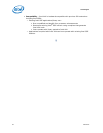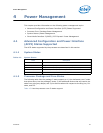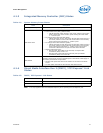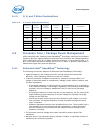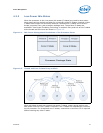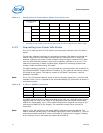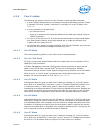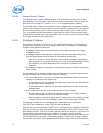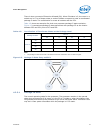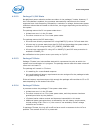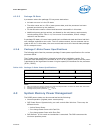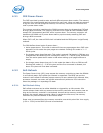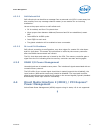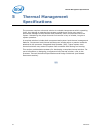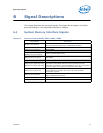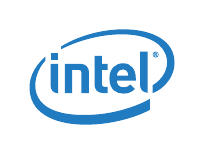
Power Management
36 Datasheet
4.2.4.6 Delayed Deep C-States
The Delayed Deep C-states (DDCst) feature on this processor replaces the “C-state
auto-demotion” scheme used in the previous processor generation. Deep C-states are
defined as CC3 through CC7 (refer to Table 4-3 for supported deep C-states).
The Delayed Deep C-states are intended to allow a staged entry into deeper C-states
whereby the processor enters a lighter, short exit-latency C-state (core C1) for a period
of time before committing to a long exit-latency deep C-state (core C3 and core C6).
This is intended to allow the processor to get past the cluster of short-duration idles,
providing each of those with a very fast wake-up time, but to still get the power benefit
of the deep C-states on the longer idles.
4.2.5 Package C-States
The processor supports C0, C1/C1E, C2, C3, and C6 power states. The following is a
summary of the general rules for package C-state entry. These apply to all package
C-states unless specified otherwise:
• A package C-state request is determined by the lowest numerical core C-state
amongst all cores.
• A package C-state is automatically resolved by the processor depending on the
core idle power states and the status of the platform components.
— Each core can be at a lower idle power state than the package if the platform
does not grant the processor permission to enter a requested package C-state.
— The platform may allow additional power savings to be realized in the
processor.
• For package C-states, the processor is not required to enter C0 before entering any
other C-state.
The processor exits a package C-state when a break event is detected. Depending on
the type of break event, the processor does the following:
• If a core break event is received, the target core is activated and the break event
message is forwarded to the target core.
— If the break event is not masked, the target core enters the core C0 state and
the processor enters package C0.
— If the break event is masked, the processor attempts to re-enter its previous
package state.
• If the break event was due to a memory access or snoop request.
— But the platform did not request to keep the processor in a higher package
C-state, the package returns to its previous C-state.
— And the platform requests a higher power C-state, the memory access or snoop
request is serviced and the package remains in the higher power C-state.
The package C-states fall into two categories: independent and coordinated.
C0/C1/C1E are independent, while C2/C3/C6 are coordinated.
Starting with the 2nd Generation Intel
®
Core™ processor family, package C-states are
based on exit latency requirements that are accumulated from the PCIe* devices, PCH,
and software sources. The level of power savings that can be achieved is a function of
the exit latency requirement from the platform. As a result, there is no fixed
relationship between the coordinated C-state of a package, and the power savings that
will be obtained from the state. Coordinated package C-states offer a range of power
savings that is a function of the guaranteed exit latency requirement from the platform.



